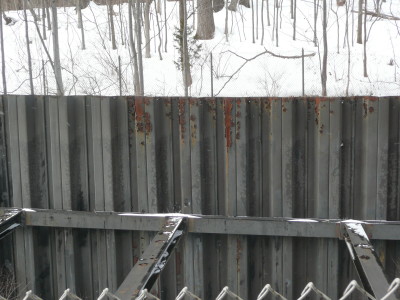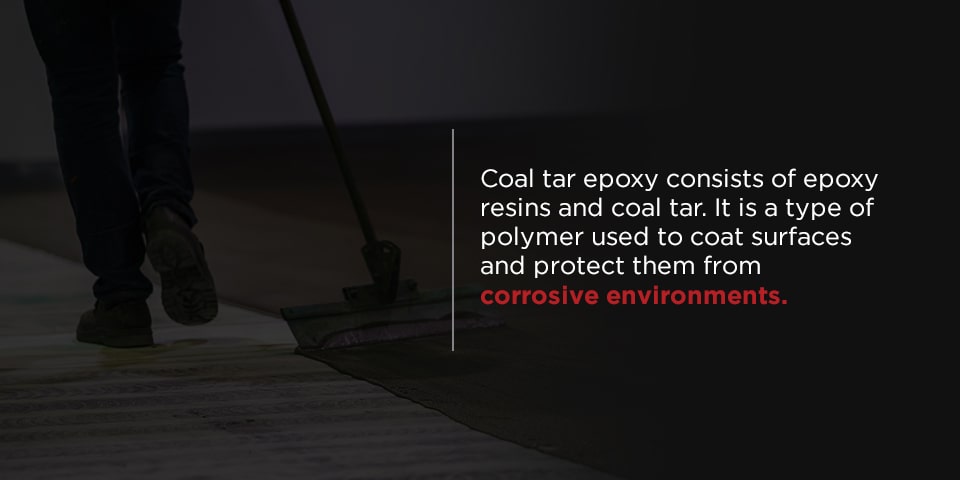
An example of a coal tar epoxy coating, flaking off from wear and tear.
Pilings provide critical support to buildings and various other structures. To help ensure that support lasts a long time, pilings need to be coated to provide resistance to the environment. If pilings are located outside above ground, they must be able to withstand extreme temperatures, as well as the effects of living organisms, external chemicals, and impact. When pilings are placed underground or in water, they face additional corrosive effects.
Coatings are applied to help preserve pilings and resist these corrosive internal and external effects. Coal tar epoxy is used as a cheap method for coating pilings, but it provides only a minimum level of protection — it is also toxic and flammable, and it may be carcinogenic. At Lane Coatings, we offer a fusion-bonded epoxy alternative to protect your pilings and avoid dangers associated with coal tar epoxy.

What Is a Coal Tar Epoxy Coating?
Coal tar epoxy consists of epoxy resins and coal tar. It is a type of polymer used to coat surfaces and protect them from corrosive environments. It is primarily used on metal and concrete in tough settings like industrial and offshore operations, where chemicals, saltwater and other substances can cause deterioration. Coal tar epoxy can offer corrosion protection through strong moisture-blocking properties.
This type of epoxy is often used because of its low cost and ease of application, but that can be said of other resin substrates, too. Many of those other substrates don’t contain the same environmental and health hazards of coal tar.
The danger of coal tar epoxy lies in the inclusion of coal tar pitch and its polycyclic aromatic hydrocarbons (PAH). Many protective agencies like the Occupational Safety and Health Association (OSHA) and the National Toxicology Program (NTP) have addressed this byproduct of coal tar. PAH is a known carcinogen, and exposure can occur via air and skin contact. Creating coal tar pitch also releases coal tar pitch volatiles, which contribute to air contamination.
Coal tar epoxy is also a significant fire hazard. It requires specific extinguishing agents and creates poisonous gases during a fire.
How Long Do Coal Tar Epoxy Coatings Last?
Coal tar epoxies typically last 20-30 years, which isn’t usually long enough for large infrastructure applications. Keep in mind that coal tar epoxy is different from coal tar enamel. If someone mentions a coal tar product that lasts 50-80 years, they’re likely referring to coal tar enamel, which is no longer used due to regulations implemented in the 1970s.
Disadvantages of Coal Tar Epoxy Coatings
While coal tar epoxy offers decent protection, it falls short in a few areas:
- Application in humid environments: Coal tar epoxy doesn’t adhere well in humid conditions and must be applied at a certain level above the dew point.
- Health and environmental concerns: Coal tar and coal tar pitch have been associated with cancers, including skin, lung, bladder, kidney and digestive tract cancer. The components of coal tar sealants can be released into the environment. Coal tar-based products have even been banned in several jurisdictions and countries.
- Poor stability: These epoxy coatings need to be stored carefully, as temperature fluctuations and cold temperatures can cause the coating to crystalize. It is also a flammable liquid with special requirements for extinguishing agents.
- Long curing process: After application, coal tar epoxy can take several weeks to cure completely before use.
If you want to address these shortcomings and improve results, an excellent coal tar epoxy alternative is fusion-bonded epoxy (FBE).
Why Fusion-Bonded Epoxy Is a Better Approach Than Coal Tar Epoxy
Fusion-bonded epoxy is a coal tar epoxy alternative that provides a better approach and improved corrosion protector performance. It offers multiple benefits:
- Superior physical and chemical stability
- Resistance to soil stress
- Impact resistance
- Good adhesion
- Resistance to cathodic disbondment, which occurs when a coating separates from the surface due to the formation of hydrogen ions.
- Capable of operating in temperatures ranging from -100F to 230F.
Lane Coatings has become very adept at applying Fusion Bonded Epoxy (FBE) to all types of metals, giving your team confidence in knowing that you are receiving a high-quality coating system and a high-performance finish. Once the surface is cleaned and grit blasted, the piling is then heated and the coating process is started. An electrostatic spray provides an even application of the fusion-bonded epoxy coatings, which melt on the heated surface.
The alternative coating preparation cools and quickly cures with a smooth but rugged finish. At that point, the piling is ready for installation. In some cases, a dual-layer coating can be used on top of a base coating. This can offer greater impact and gouge resistance, as well as a greater tolerance to high transition temperatures and ultraviolet radiation.
Finding Success With Fusion-Bonded Epoxy
Fusion-bonded epoxy has a long history and many recent improvements that make the question of coal tar epoxy vs. fusion-bonded coatings easily in favor of fusion bonding. Fusion-bonded epoxy has been reported by the U.S. Army Corps of Engineers as having superior impact resistance and resistance to cathodic disbondment.
Lane Coatings can apply fusion-bonded epoxy in single or dual-layer applications. In the long run, fusion-bonded epoxy is the better choice for protecting pilings than coal tar epoxy. You will benefit from:
- Better physical and chemical stability
- Excellent adhesion properties
- Impact damage resistance
- Cathodic disbondment resistance
- An ability to withstand large variations in temperature
Lane Coatings can handle almost any type of project requiring fusion-bonded epoxy, regardless of size or scope. We’ve been helping our customers since 1979. That’s over 40 years, and we can help you too. Contact Lane Coatings to find the solution that’s best for you and your project.

